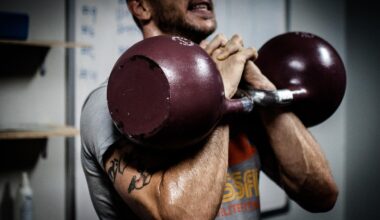Best Static Stretches for Hamstrings and Quads
Static stretching is vital in improving flexibility and mobility, particularly for the hamstrings and quadriceps. The primary goal of static stretching is to elongate the muscles, thereby reducing muscle tension and enhancing range of motion. One key benefit of static stretching is injury prevention, which is crucial for athletes and active individuals. When muscles are more flexible, they are less susceptible to strains and tears while exercising. Additionally, statically stretching these regions promotes blood circulation, which can aid recovery after strenuous activities. Certain stretches, such as the standing quadriceps stretch and seated hamstring stretch, offer profound benefits. The standing quadriceps stretch relieves tension in the front thigh muscles while enhancing balance. In contrast, the seated hamstring stretch effectively lengthens and relaxes the back of the legs. Both stretches are essential routines for those engaged in running and cycling. Engaging in a consistent static stretching program not only enhances athletic performance but can also improve everyday movements, contributing to overall better quality of life.
The Importance of Proper Technique
To maximize the benefits of static stretching, using proper technique is crucial. Incorrect methods can lead to injuries or decreased effectiveness of the stretches. For hamstrings, effective stretching involves maintaining a neutral spine to prevent discomfort. This means while reaching towards your toes, you should avoid rounding your back excessively, as this places unwanted stress on your spine. Additionally, keep your legs straight but not locked to allow for a deeper stretch without straining the knees. Similarly, with quadriceps stretches, avoid arching your back when pulling the heel towards your glutes. Instead, engage your core for added stability. The duration of each stretch also significantly impacts results; holding stretches for at least 15-30 seconds can stimulate a greater stretch response. Breathing steadily and deeply during these stretches is essential as it aids in relaxation and allows the muscles to elongate effectively. Moreover, integrating static stretching into your routine can lead to profound improvements. Schedule stretching after every workout session or on rest days to ensure optimal muscle recovery.
Here are some top static stretches specifically for the hamstrings and quadriceps muscle groups. First is the standing quadriceps stretch, which is performed by standing tall and pulling one foot towards your glutes. Ensure your knees are close together throughout the stretch to enhance its effectiveness. Next is the seated hamstring stretch; sit on the floor with one leg extended and the other bent. Reach towards the toes of your extended leg, ensuring not to round your back. These stretches not only assist in loosening tight muscles but also improve blood flow, which may reduce soreness. The butterfly stretch is another fantastic option, targeting the inner thighs while also engaging the hamstrings. For a deeper quadriceps stretch, consider the couch stretch; kneel on one knee while placing the opposite foot on a chair behind you. Breathe and hold the stretches to derive maximum advantage. Integrate these stretches into your routine to not only improve flexibility but also enhance your performance in athletic pursuits as these stretches can serve as a foundation for more advanced movements.
Combination Stretches for Flexibility
Static stretches can also be combined for effective muscle engagement. For example, a supine hamstring stretch allows for a deeper focus, contributing equally to flexibility gains. To perform, lie on your back and pull one leg up towards your chest while keeping the other leg flat on the ground. Hold lightly behind the thigh to avoid tension on the knee joint. This can enhance hip mobility along with hamstring flexibility. Another effective combination involves transitioning between hamstring and quadriceps stretches; for instance, alternate between seated forward bends and standing quad stretches. This not only maximizes the time spent stretching but provides a comprehensive routine, reaching multiple muscle groups efficiently. Incorporating these into your workout routine can be incredibly effective in building strength within muscle groups. Dynamic stretches serve as great warm-ups while static varieties finish with cool down routines. Always listen to your body and avoid overstretching, which can lead to injury. By focusing on these combination stretches, you’ll ensure comprehensive benefits that contribute to improved athletic performance.
The frequency of performing these static stretches is equally important. Ideally, incorporating a stretching routine at least three to four times a week is recommended for optimal results. Consistent practice ensures that muscles remain limber and adaptable. Morning routines can serve as an excellent way to start your day, easing any tightness built overnight. After workouts, it’s prudent to extend your routines with static stretches, targeting hamstrings and quadriceps to carry your active lifestyle into recovery. Each stretch holds value; however, avoid skipping any while focusing on particular muscle groups. Tailor your routine to suit your needs according to your exercise regimen or physical activities. Keep a stretching band or strap handy for added assistance in deepening stretches, particularly for hamstrings. Remember to employ deep breathing techniques to further relax your body and mind, enhancing overall stretching effects. By maintaining flexibility, you not only enhance your athletic performance but also allow your body to recover effectively from training sessions. Therefore, prioritize your stretching routine to cultivate longer-lasting flexibility and mobility.
Common Mistakes to Avoid
When performing static stretches, certain mistakes can lead to ineffective practices or even injury. One common error is bouncing while stretching, which can cause muscle strain. Static stretches should be performed without movement; hold each position steadily to gain maximum benefits. Another mistake involves neglecting breath control; many forget to breathe properly during stretches, which can limit muscular relaxation and tension relief. Maintaining a steady and deep breathing rhythm can amplify stretch effectiveness. Additionally, many individuals rush through their stretches, not allowing adequate time for muscle elongation. Holding stretches for at least 15 to 30 seconds is necessary to facilitate a deeper stretch and improve flexibility over time. Avoid a one-size-fits-all approach; every individual’s flexibility varies, so listen to your body’s limits and don’t force it. Include modifications or use props like blocks when needed. Stay mindful of your alignment, ensuring that your body is in a safe position throughout the execution of each stretch. Understanding these common mistakes will greatly enhance the effectiveness of your static stretching routine for hamstrings and quads.
After ensuring that proper static stretching techniques are implemented, enjoying the numerous benefits becomes easy. Improved flexibility contributes significantly to overall performance in both fitness and sports activities. Enhanced flexibility leads to better range of motion during exercises, resulting in a greater output in strength and endurance training. Static stretches for hamstrings and quads support posture in daily life and help prevent the awkward movement patterns associated with tight muscles. Moreover, incorporating these stretches can lead to faster recovery post-exercise, which diminishes muscle soreness and increases flexibility over time. Add these stretches to your overall fitness strategy for holistic muscle health. Consider pairing them with mobility training for a comprehensive routine that increases dynamic movement efficiency as well. Remember, enhancing mobility leads to improved function and reduced risk of injury when engaging in physical activities. Regular stretching promotes muscle relaxation, but makes sure to listen to your body’s signals to avoid overstretching. By prioritizing static stretching in your regimen, your overall physical performance and general wellbeing will significantly improve, allowing you to maintain an active lifestyle.
Consistency is vital in reaping the long-term benefits of static stretching. It is important to identify specific goals concerning flexibility and mobility; aim for sustainable progress in each area. Track your progress by noting any improvements in your range of motion, which reinforces the importance of your efforts. Engage with a partner or trainer who can provide guidance and feedback on correct techniques. As you progress, you may wish to explore more advanced stretches targeting similar muscle groups. Integrating a balance of static and dynamic stretching can optimize your routine, combining the benefits of both approaches. Be patient with progress because it takes time for the body to adapt and gain flexibility. Include variations to your routine to ensure engagement and avoid monotony when executing stretches. As you develop more flexibility in these areas, you might notice improvements in both performance and daily activities. Staying committed to a program of static stretches for hamstrings and quads will contribute positively to your overall wellness. Ultimately, a commitment to these strategies can ensure you lead a healthier, more mobile life.


